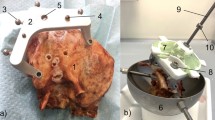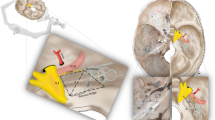Abstract
Purpose
The aim of the study was to validate a minimally invasive, multi-port approach to the internal auditory canal at the lateral skull base on a cadaver specimen.
Methods
Fiducials and a custom baseplate were fixed on a cadaver skull, and a computed tomography image was acquired. Three trajectories from the mastoid surface to the internal auditory canal were computed with a custom planning tool. A self-developed positioning system with a drill guide was attached to the baseplate. After referencing on a high precision coordinate measuring machine, the drill guide was aligned according to the planned trajectories. Drilling of three trajectories was performed with a medical stainless steel drill bit.
Results
The process of planning and drilling three trajectories to the internal auditory canal with the presented workflow and tools was successful. The mean drilling error of the system (Euclidian distance between the planned trajectory and centerline of the actual drilled canal) was \(0.53 \pm 0.12\) mm at the entry point and \(1.01\pm 0.39\) mm at the target. The inaccuracy of the drill process itself and its physical limitations were identified as the main contributing factors.
Conclusion
The presented system allows the planning and drilling of multiple minimally invasive canals at the lateral skull base. Further studies are required to reduce the drilling error and evaluate the clinical application of the system.





Similar content being viewed by others
References
Schipper J, Klenzner T, Aschendorff A, Arapakis I, Ridder GJ, Laszig R (2004) Navigation-controlled cochleostomy. Is an improvement in the quality of results for cochlear implant surgery possible? HNO 52(4):329–335
Sauerland S, Jaschinski Neugebauer EA (2010) Laparoscopic versus open surgery for suspected appendicitis. Cochrane Database Syst Rev 10:CD001546
Keus F, de Jong JA, Gooszen HG, van Laarhoven CJ (2006) Laparoscopic versus open cholecystectomy for patients with symptomatic cholecystolithiasis. Cochrane Database Syst Rev 4:CD006231
Majdani O, Rau TS, Baron S, Eilers H, Baier C, Heimann B, Ortmaier T, Bartling S, Lenarz T, Leinung M (2009) A robot-guided minimally invasive approach for cochlear implant surgery: preliminary results of a temporal bone study. Int J Comput Assist Radiol Surg 4:475–486
Bell B, Gerber N, Williamson T, Gavaghan K, Wimmer W, Caversaccio M, Weber S (2013) In vitro accuracy evaluation of image-guided robot system for direct cochlear access. Otol Neurotol 34:1284–1290
Labadie RF, Balachandran R, Noble JH, Blachon GS, Mitchell JE, Reda FA, Dawant BM, Fitzpatrick JM (2014) Minimally invasive image-guided cochlear implantation surgery: first report of clinical implementation. Laryngoscope 124:1915–1922
Wanna GB, Balachandran R, Majdani O, Mitchell J, Labadie RF (2009) Percutaneous access to the petrous apex in vitro using customized micro-stereotactic frames based on image-guided surgical technology. Acta Otolaryngol 25:1–6
Kobler JP, Nuelle K, Lexow GJ, Rau TS, Majdani O, Kahrs LA, Kotlarski J, Ortmaier T (2016) Configuration optimization and experimental accuracy evaluation of a bone-attached, parallel robot for skull surgery. Int J Comput Assist Radiol Surg 11(3):421–436
Stenin I, Hansen S, Becker M, Sakas G, Fellner D, Klenzner T, Schipper J (2014) Minimally invasive multiport surgery of the lateral skull base. Biomed Res Int 2014:379295
Yushkevich PA, Piven J, Hazlett HC, Smith RG, Ho S, Gee JC, Gerig G (2006) User-guided 3D active contour segmentation of anatomical structures: significantly improved efficiency and reliability. Neuroimage 31(3):1116–1128
Lorensen WE, Cline HE (1987) Marching cubes: a high resolution 3D surface construction algorithm. ACM Siggraph Comput Gr 21(4):163–169
Kratchman LB, Fitzpatrick JM (2013) Robotically-adjustable microstereotactic frames for image-guided neurosurgery. In: Proceedings of the SPIE 8671, medical imaging, image-guided procedures. Robotic interventions, and modeling, p 86711U. doi:10.1117/12.2008172
Balachandran R, Mitchell JE, Blachon G, Noble JH, Dawant BM, Fitzpatrick JM, Labadie RF (2010) Percutaneous cochlear implant drilling via customized frames: an in vitro study. Otolaryngol Head Neck Surg 142:421–426
Kahrs LA, McRackan TR, Labadie RF (2011) Intracochlear visualization: comparing established and novel endoscopy techniques. Otol Neurotol 32(9):1590–1595
Kobler JP, Prielozny L, Lexow GJ, Rau TS, Majdani O, Ortmaier T (2015) Mechanical characterization of bone anchors used with a bone-attached, parallel robot for skull surgery. Med Eng Phys 37(5):460–468
Nau-Hermes M (2014) Ein messtechnischer beurteilungsansatz für das verletzungsrisiko anatomischer strukturen bei bildgestützten minimalinvasiven eingriffen. Apprimus Wissenschaftsverlag, Aachen
Labadie RF, Davis BM, Fitzpatrick JM (2005) Image-guided surgery: what is the accuracy? Curr Opin Otolaryngol Head Neck Surg 13:27–31
Dillon NP, Kratchman LB, Dietrich MS, Labadie RF, Webster RJ 3rd, Withrow TJ (2013) An experimental evaluation of the force requirements for robotic mastoidectomy. Otol Neurotol 34:e93
Kobler JP, Schoppe M, Lexow GJ, Rau TS, Majdani O, Kahrs LA, Ortmaier T (2014) Temporal bone borehole accuracy for cochlear implantation influenced by drilling strategy: an in vitro study. Int J Comput Assist Radiol Surg 9(6):1033–1043
Feldmann A, Wandel J, Zysset P (2016) Reducing temperature elevation of robotic bone drilling. Med Eng Phys 38(12):1495–1504
Acknowledgements
This study was funded by the German Research Foundation FOR-1585.
Author information
Authors and Affiliations
Corresponding author
Ethics declarations
Conflict of interest
The authors declare that they have no conflict of interest.
Ethical approval
This article does not contain any studies with human participants or animals performed by any of the authors.
Rights and permissions
About this article
Cite this article
Stenin, I., Hansen, S., Nau-Hermes, M. et al. Minimally invasive, multi-port approach to the lateral skull base: a first in vitro evaluation. Int J CARS 12, 889–895 (2017). https://doi.org/10.1007/s11548-017-1533-5
Received:
Accepted:
Published:
Issue Date:
DOI: https://doi.org/10.1007/s11548-017-1533-5




